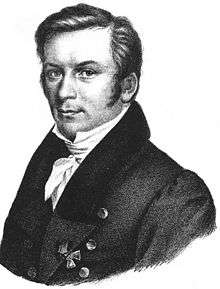Johann Friedrich von Eschscholtz
| Johann Friedrich von Eschscholtz | |
|---|---|
 | |
| Born | November 1, 1793 |
| Died | May 19, 1831 (aged 37) |
| Citizenship | Russian Empire |
| Nationality | Baltic German |
| Alma mater | University of Tartu |
| Author abbrev. (botany) | Eschsch. |
Johann Friedrich Eschscholtz (Russian: Иоганн Фридрих фон Эшшольц; November 12 [O.S. November 1] 1793 – May 19 [O.S. May 7] 1831) was a Baltic German physician, botanist, zoologist and entomologist.
Eschscholtz was born in Dorpat, Governorate of Livonia in the Russian Empire. He studied medicine at the Imperial University of Dorpat, and spent his main career there as well: extraordinary professor of anatomy (1819), director of the zoological cabinet (1822), and professor of anatomy (1828).
From 1815-1818 Eschscholtz was a physician and naturalist on the Russian circumnavigational expeditionary ship Rurik (Russian: Рюрик) under the command of Otto von Kotzebue. He collected specimens in Brazil, Chile, California, the Pacific Islands, and on either side of the Bering Strait, Kamchatka, and the Aleutian Islands. One of the other naturalists was the botanist Adelbert von Chamisso, who took over Eschscholtz's specimens, excepting insects on completion of the voyage. The two were close friends and Chamisso named the California poppy Eschscholzia californica in his honour. The results of the trip were published in the Berlin journal Entomographien in 1822.
From 1823-1826 Eschscholtz went on a second circumnavigational voyage, this time on the ship Predpriaetie (Russian: Предприятие), or Enterprise. Again, Kotzebue was the commander. Large collections, mainly of Coleoptera, were made in the tropics and at Unalaska, Sitka, and in California.
Before his early death Eschscholtz visited the French coleopterist Pierre François Marie Auguste Dejean. Eschscholtz described the Coleoptera he had collected using Dejean’s collection to decide which were new. The binomial names he gave them as well the descriptions were published by Dejean after Eschscholtz's death. These were attributed to Eschscholtz by Dejean but the rules of nomenclature were later properly applied and excluded him.
Eschscholtz was one of the first and most important scientists in the exploration of the Pacific, Alaska, and California. Among his publications were the System der Akalephen (1829), and the Zoologischer Atlas (1829–1833). Eschscholtz was the first naturalist to describe the acorn worm (Balanoglossus), which he encountered in the Marshall Islands in 1825.
Kotzebue named an island in the Marshall Islands as Eschscholtz Atoll. This was renamed in 1946 to Bikini Atoll. Kotzebue also named a small bay east of Kotzebue Sound after Eschscholtz.
His insect collections are in the Zoological Museum in Moscow and in the natural history museums of Tartu and Helsinki.
See also
Notes
Sources
- Essig, E. O. (1931) History of Entomology.
- Pont, A. C. (1995). The dipterist C. R. W. Wiedemann (1770–1840). His life, work and collections. Steenstrupia 21: 125 - 154.
- Wikipedia article on botanists (now merged).